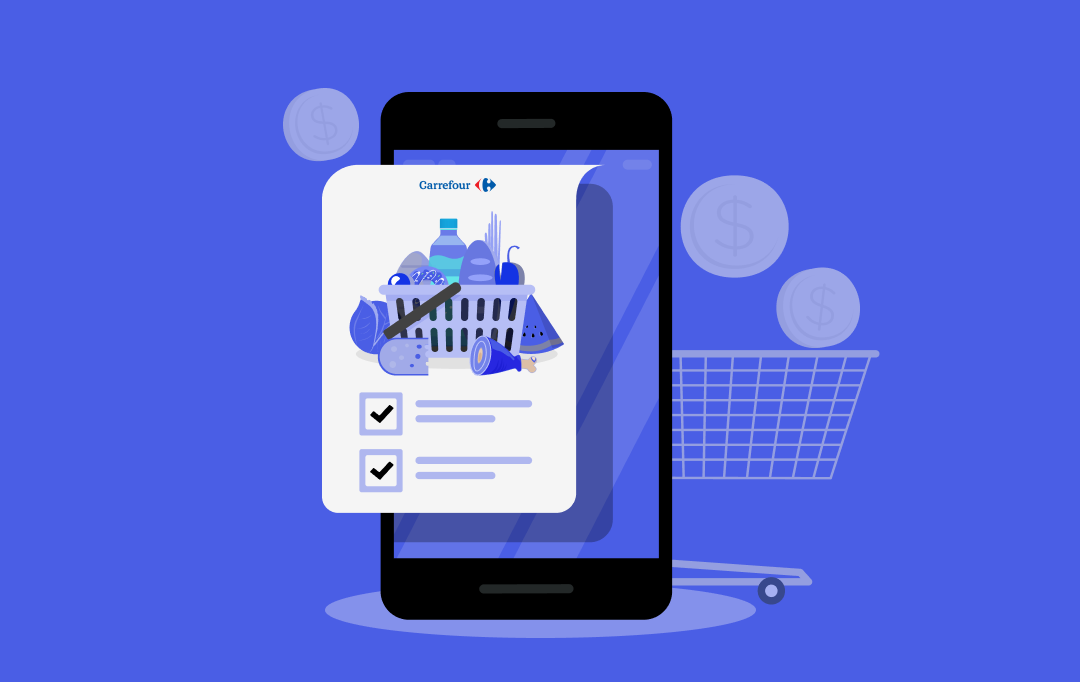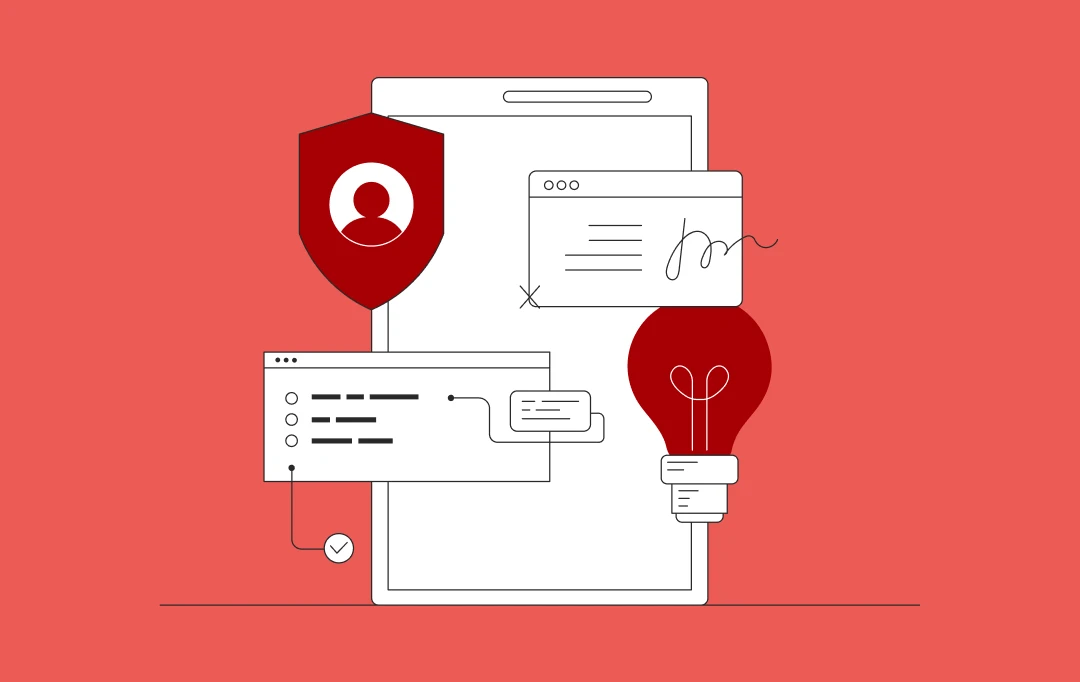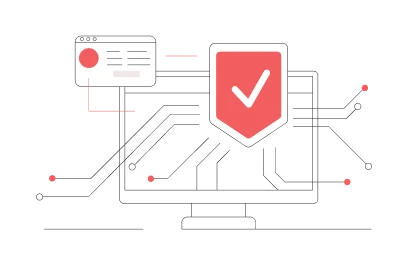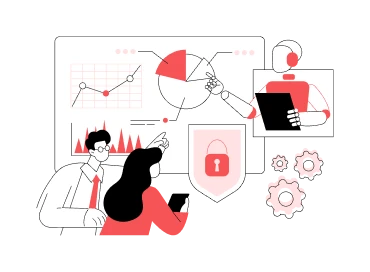- Why Application Security Needs SIEM in Australia Today?
- How Does SIEM Strengthen Application Security?
- Log Management: From Raw Noise to Actionable Insight
- Event Correlation Across Multiple Layers
- Real-Time Monitoring and Alerts
- SIEM and AI-Driven Threat Detection
- Threat Intelligence Integration in SIEM
- Pulling It All Together
- Key SIEM Use Cases for Application Security
- 1. Financial Services: Detecting API Exploits in Real Time
- 2. Healthcare: Safeguarding Sensitive Patient Records
- 3. Retail & E-Commerce: Preventing Insider Threats
- 4. SaaS & Cloud Platforms: Managing Microservices at Scale
- 5. Compliance and Audit Readiness
- The Cost Dimension of Investing in SIEM for Application Security
- The cost to develop secure app with SIEM
- Ongoing Costs - Training, Tuning, Integration
- In-House vs. Managed SIEM in Australia
- ROI Perspective
- What are the Implementation Challenges and Best Practices
- Common Pitfalls in SIEM Deployment
- Best Practices for Successful SIEM
- From Challenges to Compliance
- How to Find Compliance and Regulatory Alignment in Australia?
- APRA Prudential Standards
- ACSC and the Essential Eight
- ISO 27001 Alignment
- GDPR and Cross-Border Data Protection
- Why SIEM is a Compliance Multiplier
- Preparing for Tomorrow’s Audits
- The Future of SIEM and AI for Modern Application Security
- Beyond Traditional Correlation
- Anomaly Detection at Scale
- Reducing False Positives, Enhancing Response
- Adaptive Learning in a Cloud-Native World
- Integrating Threat Intelligence
- What This Means for the Future
- From Innovation to Strategy
- Where Does Appinventiv Fit in the Strategic Role of SIEM?
- FAQs
- SIEM empowers Australian organisations to detect and respond to application-layer threats in real time, reducing the risk of costly breaches.
- Integrating SIEM into your app security strategy streamlines compliance with APRA, ACSC, and other critical Australian regulations.
- By centralising and correlating security data, SIEM enables faster, smarter decision-making and helps protect sensitive customer information.
- Choosing managed SIEM services provides enterprise-level security and monitoring without the overhead of building an in-house SOC.
It started with a small anomaly – unusual login attempts on a customer-facing app at an Australian fintech. Within hours, what looked like harmless noise had escalated into a coordinated attack – API abuse, data exfiltration attempts, and privilege escalation all unfolding in real time. The organisation’s network firewalls never raised an alarm, because the attackers weren’t targeting the perimeter. They were already inside the application layer.
Incidents like this are no longer rare. Across industries in Australia – banking, healthcare, SaaS, and government – applications are the new prize for cybercriminals. And without advanced visibility, security teams are often left detecting the breach after the damage is done.
This is where SIEM for app security in Australia changes the game. By correlating logs, monitoring in real time, and applying intelligent analytics, SIEM helps organisations not just detect threats but act before they spiral.
Why Application Security Needs SIEM in Australia Today?
In today’s digital economy, applications are no longer simple monolithic systems. They now run on cloud-native stacks, linked through APIs, and spread across microservices. This innovation speeds delivery but also expands the attack surface in ways old defenses can’t cover. Attackers no longer need to breach a data center; they look for weak endpoints, container flaws, or forgotten logs to sneak in unnoticed.
This evolving threat landscape highlights the critical role of SIEM for app security in Australia. By making hidden activity visible, SIEM in application security Australia equips teams to spot issues early and act before small risks become major breaches. Unlike generic SIEM deployments that focus primarily on network or endpoint events, SIEM in application security Australia zeroes in on the application layer. It correlates logs from APIs, containers, databases, and identity systems, creating a unified lens through which hidden anomalies become visible.
Instead of just raising a red flag at the network edge, SIEM in application security follows the activity where it really matters – inside the app. It can connect unusual login patterns with API misuse or spot odd behaviour across microservices and cloud workloads all at once.
That’s the difference between a generic tool and SIEM for app security in Australia designed to protect modern digital systems. For Australian organisations bound by strict compliance and trust requirements, that visibility can be the difference between swiftly containing a threat and becoming the next breach headline.
How Does SIEM Strengthen Application Security?
For modern organisations, the real question isn’t if attackers will test your applications – it’s when. The advantage lies in how quickly you notice the signals, link them together, and act with certainty. That’s why SIEM in application security in Australia delivers value well beyond storing logs.
With the right approach, SIEM for app security becomes a frontline system that translates scattered events into clear, actionable insight. Let’s break down how SIEM strengthens the application layer in practice.
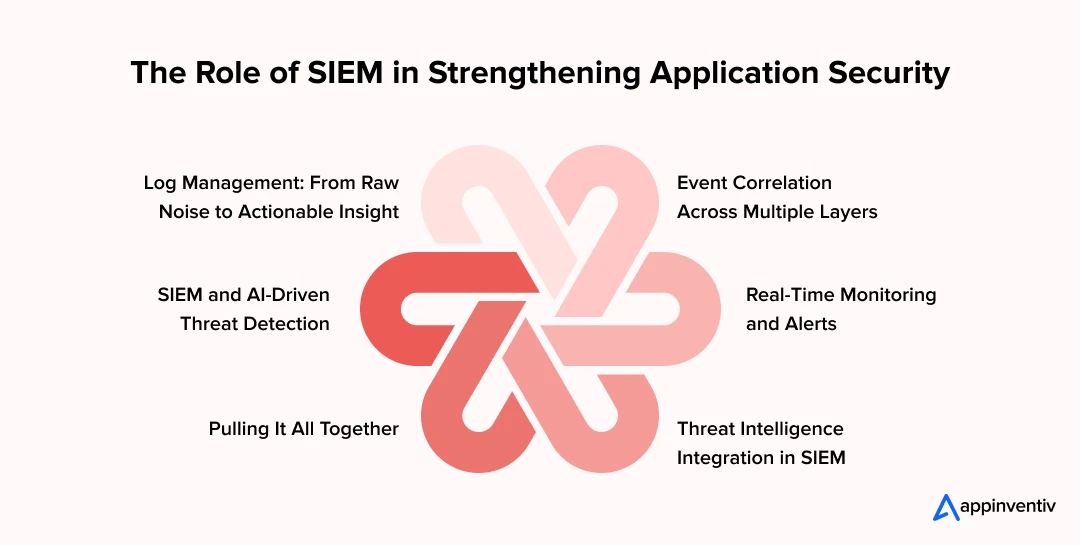
Log Management: From Raw Noise to Actionable Insight
Every digital interaction – user login, API call, database request – leaves a trace. On their own, these logs are often overwhelming and fragmented across platforms. SIEM consolidates them into one stream of intelligence.
Take an Australian retail brand hit by credential-stuffing. With SIEM for app security, unusual login attempts across web and mobile apps can be tied together and traced back to the same attacker. Instead of scattered alerts, SIEM in application security in Australia gives analysts a single view of the incident, making it clear how wide the threat really is – something that might otherwise stay invisible.
Event Correlation Across Multiple Layers
Threats rarely announce themselves in isolation. A phishing login attempt may be followed by suspicious API activity, which then leads to unauthorized database queries. SIEM’s correlation engine ties together these dispersed events into a coherent story. This becomes critical in cloud-native applications, where microservices often stretch across several environments.
With SIEM in application security, connected anomalies don’t stay buried – they are surfaced as early warning signs that a coordinated attack may already be in motion. That’s the strength of SIEM for app security in Australia: turning scattered technical noise into a clear signal for action.
Real-Time Monitoring and Alerts
Speed matters in cyber defense. A delay of even a few minutes can mean stolen healthcare records or blocked financial transactions. With SIEM for app security in Australia, real-time monitoring ensures that critical alerts reach the right teams instantly. This is not just about logs – it’s about Intelligent Security Monitoring using SIEM that links patterns across apps and infrastructure.
Imagine a Sydney hospital’s patient system noticing a surge in API requests at midnight. SIEM in application security can immediately flag the anomaly, notify the security operations center, and trigger containment before access escalates.
It’s a clear example of how SIEM in cyber security moves from being reactive to truly preventive.
SIEM and AI-Driven Threat Detection
Static, rule-based alerts can’t keep up with the tactics of modern adversaries. That’s why application security with SIEM in Australia is shifting toward AI-driven detection that learns normal behavior patterns and flags outliers.
Imagine an employee suddenly downloading gigabytes of sensitive data outside business hours – machine learning algorithms and models inside the SIEM would treat it as a likely insider threat. Combined with threat intelligence integration SIEM, this approach not only reduces false positives but also helps analysts focus their attention on the risks that matter most. It’s the partnership of human expertise and machine intelligence that gives organisations a real edge.
Threat Intelligence Integration in SIEM
Modern defense also depends on staying informed about the latest adversary techniques. Threat intelligence integration in SIEM brings external data – ranging from global malware signatures to region-specific alerts from the Australian Cyber Security Centre (ACSC) – directly into the platform. By enriching local log data with this intelligence, organisations can detect known exploits targeting the financial and healthcare sectors before they take root.
Pulling It All Together
When brought together, these capabilities show why SIEM is far more than a compliance checkbox. It becomes the backbone of resilient application defense. Through unified visibility, intelligent detection, and proactive safeguards, application security with SIEM in Australia helps businesses maintain customer trust, satisfy regulators, and defend against adversaries who increasingly target the app layer.
For teams seeking guidance, there are also Australian resources for SIEM and application security – from ACSC frameworks to APRA requirements – that provide clear direction on aligning technology with local compliance needs.
Key SIEM Use Cases for Application Security
Talking about capabilities is one thing. But what truly proves SIEM’s value is how it works in real-world environments. Across industries in Australia, organisations are using SIEM not only to monitor but to transform the way applications are protected. The following SIEM use cases in app security highlight how Australian enterprises apply the technology at scale.
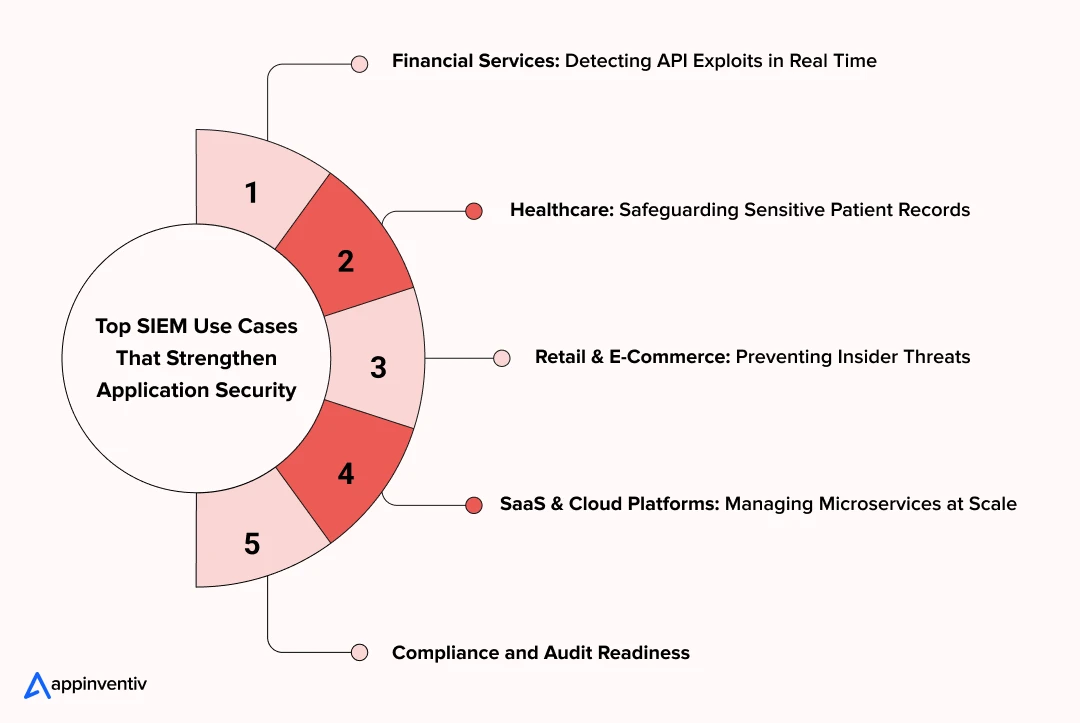
1. Financial Services: Detecting API Exploits in Real Time
Banks and fintechs rely heavily on APIs to connect mobile apps, payment gateways, and third-party partners. But these APIs are also prime targets for attackers.
Imagine a scenario where a Melbourne-based digital bank notices abnormal transaction requests coming from its mobile app. A conventional monitoring tool might not piece together the pattern, but SIEM correlates the API logs, transaction data, and user behavior to flag the exploit in real time. This illustrates the core value of SIEM tools for modern threat protection – catching anomalies across layers before they escalate into multimillion-dollar breaches.
2. Healthcare: Safeguarding Sensitive Patient Records
Hospitals and healthcare providers in Australia manage massive amounts of sensitive personal data, all governed by strict OAIC privacy requirements. In one case, a healthcare system faced credential stuffing attacks where stolen passwords from unrelated breaches were being tested on its patient portal. With SIEM, every login attempt was captured, and the event correlation engine detected repeated failed attempts from unusual geographies. The system not only blocked malicious traffic but also triggered automated alerts to the security team.
This demonstrates how organisations can leverage SIEM to build safer apps – apps that are resilient, compliant, and capable of protecting human lives as much as digital assets.
3. Retail & E-Commerce: Preventing Insider Threats
Retailers increasingly depend on e-commerce platforms where customer trust is everything. One Australian retailer deployed SIEM to detect unusual activity in its order management system. Logs revealed a privileged user downloading large data sets after midnight – an activity invisible to standard access controls. SIEM’s AI-driven threat detection classified it as a high-risk insider event. By integrating threat intelligence into SIEM, the system confirmed that the exfiltrated data matched patterns seen in dark web marketplaces.
Here, the benefit was not just compliance but preventing brand-damaging data leaks.
4. SaaS & Cloud Platforms: Managing Microservices at Scale
For SaaS providers, especially those operating cloud-native microservices, visibility is notoriously difficult. Each container, function, and service generates its own log stream. Without SIEM, security analysts are left chasing fragments of the story.
By deploying a modern platform, a Sydney-based SaaS startup unified its microservice logs into a central SIEM. When a compromised API token was used across multiple services, the SIEM quickly correlated the chain of events and isolated the breach before data exfiltration. This is one of the clearest SIEM use cases in app security – restoring visibility in environments too complex for manual oversight.
5. Compliance and Audit Readiness
Regulators in Australia, from APRA in financial services to ACSC across critical industries, are raising the bar for compliance. SIEM not only helps meet these requirements but streamlines audits. By retaining and organising application logs for extended periods, SIEM ensures that organisations can quickly provide evidence of security controls in action. For enterprises, this reduces audit fatigue while reassuring both customers and regulators. From banks detecting API exploits to hospitals protecting patient portals, the message is clear: SIEM is not an optional add-on but an operational necessity.
Real-world cases highlight how enterprise SIEM implementation examples consistently prove its value. And with threat intelligence integration SIEM, these systems don’t just react to incidents – they anticipate evolving tactics, making applications safer, compliant, and resilient in the face of digital transformation in Australia. For enterprises, adopting SIEM tools for modern threat protection means gaining not just security but the confidence to innovate without fear.
The Cost Dimension of Investing in SIEM for Application Security
For security leaders in Australia, protecting applications is as much a financial question as it is a technical one. Budgets are finite, yet breaches routinely cost organisations millions. IBM’s 2024 Cost of a Data Breach Report found that the average incident in Australia now costs around AUD 4.2 million. Against that reality, implementing SIEM platform solutions isn’t just another expense – it’s a safeguard that pays off over time.
When businesses compare the cost to develop a secure app with SIEM to the reputational damage and financial losses of a breach, the return on investment is hard to ignore. That’s why so many turn to managed SIEM Australia providers, gaining enterprise-grade protection with predictable costs and access to skills that are often scarce in-house.
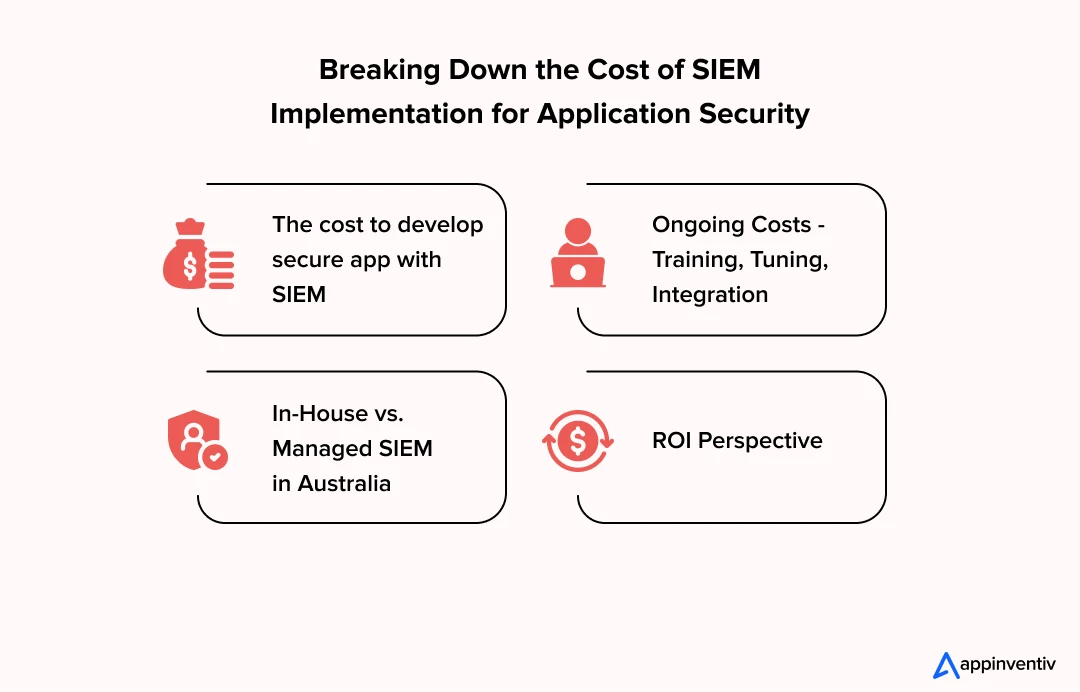
The cost to develop secure app with SIEM
Building security into applications from the start is cheaper than bolting it on later. Consider a Melbourne-based fintech developing a new payments app. By integrating SIEM connectors into its DevOps pipeline, it invested roughly AUD 250,000 upfront in licenses, integrations, and developer time. The real payoff came from avoiding what would have been a much higher cost to develop a secure app with SIEM if left until later – when an API exploit might have triggered APRA fines and damaged reputation.
The takeaway is straightforward: building in implementing SIEM platform capabilities during development lowers risk and helps businesses sidestep the hidden costs of rework, remediation, and even legal penalties. For organizations that prefer predictable spending and specialist oversight, managed SIEM Australia offerings make enterprise-grade protection more accessible.
In today’s climate, where every app is a target, SIEM isn’t optional; it’s simply part of the cost of doing business securely.
Ongoing Costs – Training, Tuning, Integration
Deploying SIEM is not a “one-and-done” task. To deliver value, it must evolve with your environment. Typical ongoing costs in Australia include:
- Training: AUD 50k–80k annually for analyst training to interpret alerts and fine-tune rules.
- Tuning: AUD 30k–50k per year to adjust correlation rules as applications and threats evolve.
- Integration: AUD 40k–100k annually for ongoing integration with new SaaS tools, APIs, and microservices.
While these figures add up, the alternative is an under-tuned SIEM producing noise instead of insight. Proper investment ensures the platform delivers accurate alerts and measurable risk reduction.
In-House vs. Managed SIEM in Australia
One of the most important choices for any organisation is whether to run SIEM in-house or partner with a managed service provider.
- In-House SIEM: Large enterprises with established SOCs often face annual costs of AUD 1 to 1.5 million once staffing, infrastructure, and 24/7 monitoring are included. This path offers maximum control, but the drawback is clear: Australia’s shortage of skilled cybersecurity professionals makes it difficult to keep a SOC fully staffed.
- Managed SIEM Australia: Many mid-sized organisations take this route, with annual costs typically between AUD 150,000 and 400,000 depending on log volumes and service tiers. It provides enterprise-grade monitoring without the burden of recruiting and training staff, which often leads to faster time-to-value and stronger ROI.
Both approaches are viable – the right choice depends on scale, maturity, and budget. But whichever option an organisation takes, implementing SIEM platform solutions is essential for maintaining visibility and meeting compliance obligations across modern applications.
ROI Perspective
Security investment always competes with other IT priorities, but SIEM consistently proves its worth. When set against the average breach cost of AUD 4.2 million, the annual spend on SIEM seems modest. Factor in potential penalties under Australia’s Privacy Act – which can climb as high as AUD 50 million for serious or repeated breaches – and the cost-benefit case becomes impossible to ignore.
For many organisations, weighing this against the cost to develop a secure app with SIEM highlights the point clearly: the upfront investment is far smaller than the long-term financial and reputational damage of failing to act.
Moreover, SIEM supports more than just defense. By producing clean, centralized audit logs, it streamlines regulatory reporting for APRA, OAIC, and ACSC requirements – saving both time and external audit fees. In effect, the ROI extends beyond security to operational efficiency and regulatory trust.
The real cost question isn’t “Can we afford SIEM?” but “Can we afford to operate without it?” Whether handled in-house or through a partner, the investment in implementing SIEM platform capabilities quickly proves its worth – helping organisations avoid breach costs, satisfy regulators, and build customer confidence.
For many, working with managed SIEM Australia providers speeds up that return, offering enterprise-grade protection without the heavy expense of running a full SOC internally. For Australian businesses, SIEM isn’t just a defensive measure – it’s an enabler of innovation, ensuring applications can grow and scale securely in an increasingly hostile digital landscape.
What are the Implementation Challenges and Best Practices
If the decision to invest in SIEM is clear, the next hurdle is successful execution. Many Australian enterprises underestimate just how challenging SIEM deployment can be. SIEM tools in cyber security are powerful, but they’re no silver bullet. Without solid planning, they can quickly turn costly, overwhelm teams with noise, or end up underused not long after deployment. The organisations that see real value are the ones that recognise the common pitfalls and apply proven best practices – turning the investment into genuine protection instead of wasted spend.
Common Pitfalls in SIEM Deployment
Deploying a Security Information and Event Management (SIEM) system is a complex process that requires careful planning and execution. While SIEM provides immense value in detecting and responding to security threats, many businesses face challenges during deployment, from integration issues to scalability concerns. Let’s explore the most common pitfalls and how to avoid them to ensure a successful SIEM deployment.
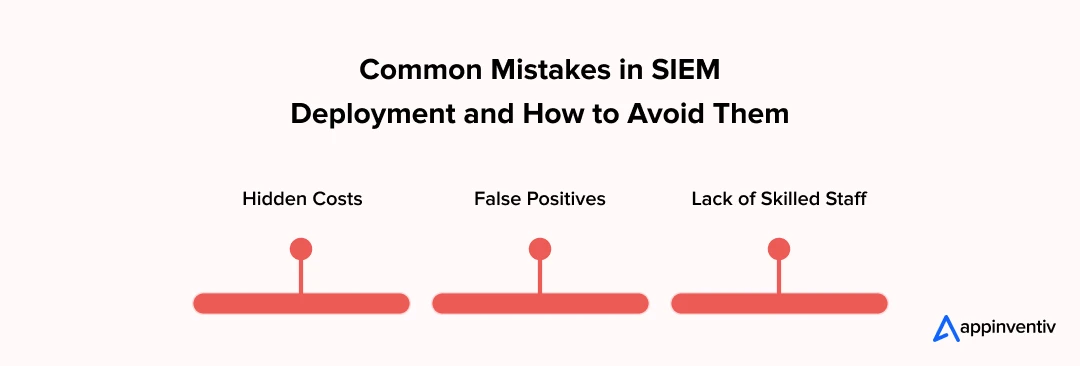
- Hidden Costs
The licensing fee is only the beginning. Organisations often fail to account for training, ongoing tuning, and integration costs. For one Queensland-based healthcare provider, the first year of SIEM ownership ran 40% above budget because these hidden elements weren’t factored in. - False Positives
A poorly tuned SIEM can overwhelm analysts with alerts, many of which are benign. This “alert fatigue” causes teams to miss the real threats hiding in the noise. In some Australian banks, SIEM implementations generated tens of thousands of alerts per day before tuning, stretching SOC teams to their limits. - Lack of Skilled Staff
Australia’s cyber skills shortage is well known. Running SIEM internally demands experienced analysts who can interpret data, tune detection rules, and maintain integrations. Without that expertise on hand, even the best SIEM tools in cyber security risk being underused – or worse, reduced to expensive shelfware.
Best Practices for Successful SIEM
By following industry best practices, businesses can maximize the value of their SIEM investment, ensuring enhanced threat detection, faster response times, and improved overall security posture. Let’s explore the key best practices to achieve SIEM success.
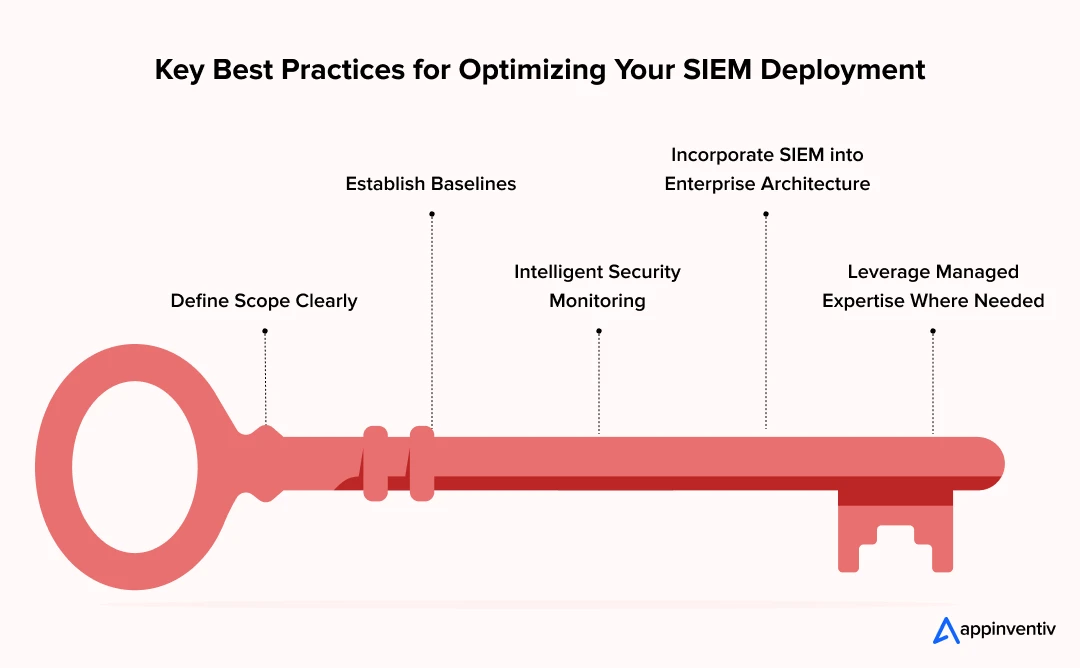
- Define Scope Clearly
Before deployment, organisations must define what they expect from SIEM. Is the focus compliance, insider threat detection, or API monitoring? Setting scope prevents misalignment between expectations and outcomes. - Establish Baselines
SIEM becomes most valuable when it understands “normal” behaviour. Baselines – such as typical login times, transaction volumes, or API request rates – enable the system to flag anomalies accurately. For example, when an e-commerce platform in Sydney set baselines for order volumes, SIEM was able to detect subtle carding attacks early. - Intelligent Security Monitoring
At its heart, SIEM is about turning raw logs into real intelligence. Effective monitoring means tuning the system to spotlight high-risk activities while cutting out background noise. This is where SIEM for real-time monitoring and alerts proves its worth – catching privilege escalation, abnormal API calls, or data exfiltration as it unfolds, not hours later when the damage is already done. - Incorporate SIEM into Enterprise Architecture
Too often, SIEM is deployed as a standalone tool. Instead, it should be woven into the enterprise security architecture – integrated with firewalls, IAM systems, cloud-native monitoring tools, and even DevOps workflows. - Leverage Managed Expertise Where Needed
For organizations facing ongoing staff shortages, turning to managed SIEM is often the smartest path forward. These providers deliver round-the-clock monitoring and advanced analytics, allowing enterprises to unlock the full value of SIEM tools in cyber security without carrying the heavy overhead of running a dedicated in-house SOC.
From Challenges to Compliance
Getting SIEM right is about balance – between cost and coverage, visibility and noise, in-house expertise and external support. When those elements align, SIEM becomes the backbone of intelligent defense.
But technical success is only part of the equation. In Australia, the bigger question is: can your organisation prove compliance? APRA, ACSC, and OAIC requirements demand more than tools; they require demonstrable accountability. That’s where SIEM provides the audit trail, the evidence, and the confidence regulators expect.
How to Find Compliance and Regulatory Alignment in Australia?
For many Australian organisations, security isn’t only about stopping attackers – it’s about proving to regulators, customers, and partners that systems are governed responsibly. The reality is that even if a breach is contained quickly, failing to demonstrate compliance can result in significant penalties and reputational fallout. That’s why SIEM has become central to meeting SIEM compliance requirements Australia regulators expect.
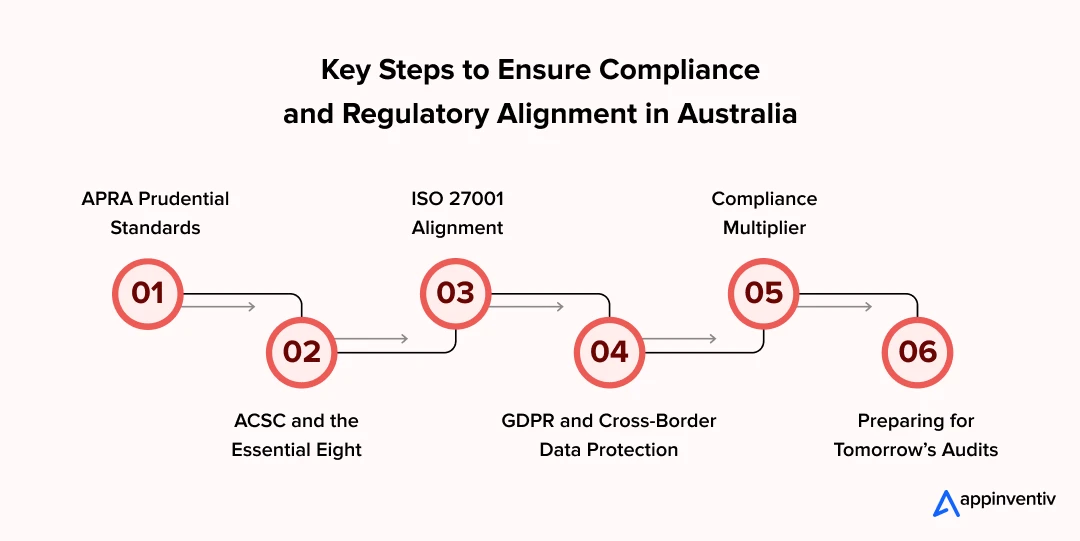
APRA Prudential Standards
Financial institutions regulated by the Australian Prudential Regulation Authority (APRA) tend to face extremely stringent obligations around operational resilience and information security. Standards like CPS 234 demand that entities maintain clear evidence of incident detection, response, and reporting. Meeting these SIEM compliance requirements Australia is challenging without a central system to capture logs, correlate events, and generate audit-ready reports – and that’s exactly where SIEM proves its value.
ACSC and the Essential Eight
The Australian Cyber Security Centre (ACSC) highlights the Essential Eight as the baseline for cyber defence. Key among these are monitoring privileged access, spotting unusual user behaviour, and keeping clear visibility into application events. Aligning with these SIEM compliance requirements Australia allows organisations to show more than policy adoption – it proves that security controls are actively working and delivering measurable outcomes across their application environments.
SIEM tracks authentication and privilege use, ensuring administrative actions are logged.
- It validates patch management and change controls through log correlation.
- It helps organisations demonstrate maturity levels in Essential Eight audits.
For many enterprises, SIEM is the only way to achieve continuous alignment with ACSC’s recommendations across the entire range of complex, cloud-native environments.
ISO 27001 Alignment
For enterprises pursuing global contracts, ISO/IEC 27001 certification remains the recognized benchmark for information security management. Meeting these SIEM compliance requirements Australia often overlaps with ISO expectations, and SIEM plays a central role in evidencing controls under Annex A – such as:
- A.12.4 (logging and monitoring) → SIEM centralises log management.
- A.16.1 (incident management) → SIEM accelerates detection and reporting.
- A.18.1 (compliance with legal requirements) → SIEM provides immutable records for audit purposes.
Australian SaaS providers, for example, often rely on SIEM to show international clients that they don’t just meet local laws but also adhere to globally recognised frameworks.
GDPR and Cross-Border Data Protection
Although the General Data Protection Regulation (GDPR) originates in Europe, its reach extends to Australian businesses that handle EU citizen data. The law requires breach notifications within 72 hours and evidence of proper monitoring. SIEM helps meet these compliance requirements in Australia by timestamping incidents, automating alerts, and generating reports ready for auditors. Without these capabilities in place, demonstrating GDPR readiness becomes nearly impossible.
Why SIEM is a Compliance Multiplier
Across these frameworks – APRA, ACSC, Essential Eight, ISO, and GDPR – there’s a common thread: the need for visibility, evidence, and accountability. SIEM addresses all three. It doesn’t replace policies or governance – it brings them to life. Rather than treating compliance as a box-ticking exercise, organisations can use SIEM as a true compliance multiplier. By aligning with SIEM compliance requirements Australia, businesses create living proof that controls aren’t just written down but actively monitored and enforced in real time.
Preparing for Tomorrow’s Audits
Australian regulators continue to tighten expectations. The Privacy Act review signals tougher breach notification rules, while APRA has already announced stronger enforcement of CPS 234 obligations. Enterprises that delay aligning SIEM with these frameworks risk costly remediation later. Meeting SIEM compliance requirements Australia today is about staying ahead of audits tomorrow.
The Future of SIEM and AI for Modern Application Security
If compliance defines today’s priorities, innovation defines tomorrow’s. The sheer scale and complexity of application-layer data have already pushed traditional monitoring methods to their limits. With millions of log entries generated every hour – from microservices, APIs, user actions, and third-party integrations – manual correlation is no longer sustainable. This is where the convergence of SIEM and AI-driven threat detection is rewriting the playbook for modern security.
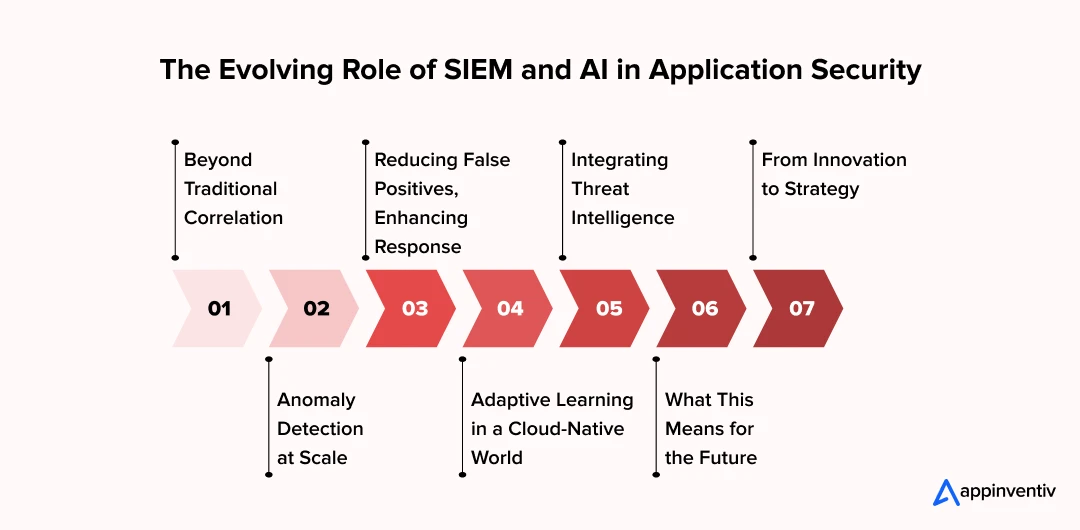
Beyond Traditional Correlation
Classic SIEM relies on predefined rules: “if X happens, trigger Y alert.” But in an application environment that shifts daily – containers spinning up and down, new APIs being deployed – static rules fall short. AI-driven SIEM changes this dynamic by learning what “normal” looks like and automatically flagging deviations that rules may miss.
Anomaly Detection at Scale
In application security, threats rarely follow neat or predictable patterns. An attacker might slow their requests to slip under rate limits, mask traffic so it looks routine, or twist business logic in ways the system wasn’t designed to handle. That’s where anomaly detection shows its value. By tracking behaviours across logins, session times, and transaction flows, an AI-enabled SIEM can catch the small signals others miss – and flag malicious intent before it becomes a serious breach
This is the essence of SIEM and AI-driven threat detection – transforming what once looked like a flood of raw logs into intelligence that anticipates attacks instead of merely reacting to them.
Reducing False Positives, Enhancing Response
One of the biggest frustrations with SIEM has always been false positives. Analysts flooded with noisy alerts either overlook real incidents or waste hours chasing harmless ones. AI app development services in Australia address this by ranking alerts on the basis of context, likelihood, and risk, this way, instead of chasing shadows, security teams can focus on the few incidents which actually matter.
For Australian enterprises already facing a shortage of skilled cybersecurity staff, this efficiency is transformative. It shifts SIEM from a reactive burden to a proactive ally – and explains why so many now turn to SIEM solutions for application security in Australia to keep pace with today’s complex threats.
Adaptive Learning in a Cloud-Native World
The modern Australian enterprise doesn’t just run apps – it operates across multi-cloud, API-driven, microservice-based environments. These systems evolve so quickly that yesterday’s security posture may already be outdated. AI-enabled SIEM adapts on its own, retraining models to recognise new behaviours without endless manual rule updates. This adaptability is why SIEM solutions for application security in Australia are becoming indispensable: they let businesses keep pace with constant change and defend applications at the speed they evolve.
This agility makes AI-enhanced SIEM solutions for application security in Australia especially valuable. Whether it’s a healthcare provider rolling out a new telehealth platform or a retailer scaling e-commerce infrastructure during holiday sales, AI keeps the SIEM environment current and relevant.
Integrating Threat Intelligence
The next leap is combining anomaly detection with global threat intelligence. By merging real-time logs with feeds on emerging attack vectors, AI can correlate local anomalies with global patterns. Imagine an Australian bank detecting an unusual login pattern that, when cross-referenced, matches attack activity seen hours earlier in Singapore. AI doesn’t just see the log – it understands the context, enabling pre-emptive action.
What This Means for the Future
Looking ahead, SIEM won’t simply be about compliance reports or centralised logging. It will become a predictive engine at the core of application security. When automation, intelligence, and adaptability come together, SIEM and AI-driven threat detection gives enterprises the ability to defend against threats that don’t even exist yet.
For CTOs and CISOs, the message is straightforward: adopting AI-enabled SIEM solutions for application security in Australia isn’t just another upgrade. It’s a way to future-proof the organisation against an unpredictable and increasingly hostile threat landscape.
From Innovation to Strategy
AI isn’t rewriting the fundamentals of SIEM – it’s strengthening them. The real advantage will go to organisations that see SIEM as more than a compliance task and start treating it as a strategic capability. Those that adopt AI-driven SIEM now will be far better prepared to handle tomorrow’s risks, tighter regulations, and rising customer expectations.
Where Does Appinventiv Fit in the Strategic Role of SIEM?
The journey to strong application security doesn’t stop with technology – it depends on the right partner to design, implement, and optimize it. This is where Appinventiv fits in. As one of the leading app developers in Australia, we don’t just build digital products; we engineer them with security woven into every layer.
From embedding SIEM for app security in Australia to integrating intelligent monitoring across cloud-native environments, our approach ensures that applications are resilient by design. For enterprises navigating APRA, ACSC, or ISO compliance, we help transform SIEM from a regulatory necessity into a true enabler of trust and innovation.
In a landscape where threats evolve daily, our role is to make sure your applications aren’t just functional, but future-ready. By combining development expertise with deep security alignment, Appinventiv positions SIEM as more than a checkbox – it becomes the foundation of lasting resilience. Connect with us now.
FAQs
Q. What is SIEM and why is it important for application security?
A. Think of SIEM as the security control room for your apps. It pulls in logs from everywhere – servers, APIs, users – and shows you what’s really happening. Without it, threats hide in the noise. With it, you get visibility and a chance to act before things blow up.
Q. How does SIEM protect applications from modern threats?
A. Most modern attacks don’t shout; they whisper. SIEM spots the whispers. Say someone logs in at 3 a.m. from overseas, then downloads a bunch of files – that is suspicious. SIEM connects the dots fast and raises the flag before it turns into a headline.
Q. What are the benefits of implementing SIEM for app security in Australia?
A. It’s not just about security. SIEM saves time for stretched IT teams, helps tick compliance boxes, and protects brand trust. For Aussie businesses, it often pays for itself by avoiding fines or PR nightmares after a breach.
Q. Is SIEM required for regulatory compliance in Australia?
A. Not always written word-for-word in the rules – but the regs (APRA, ACSC, Privacy Act) all demand monitoring and quick response. SIEM is the easiest way to prove you’re doing that. So while “required” isn’t the word, in practice it’s close.
Q. How does AI enhance SIEM performance?
A. AI makes SIEM smarter. Instead of just following set rules, it learns what “normal” looks like and calls out the weird stuff. That means fewer false alarms and quicker catch on new tricks hackers use.
Q. What industries in Australia benefit most from SIEM?
A. Any industry that runs on apps: banks protecting transactions, hospitals guarding patient data, retailers keeping online shopping safe. Even government portals use it. If apps drive your business, SIEM helps.
Q. How can businesses choose the right Aussie SIEM solution?
A. Start with your needs. Big enterprise? Maybe in-house. Smaller team? Managed SIEM might fit better. For Australia, make sure it aligns with local rules and offers local support. And if you’re building apps, working with trusted app developers in Australia helps bake security in from day one.


- In just 2 mins you will get a response
- Your idea is 100% protected by our Non Disclosure Agreement.
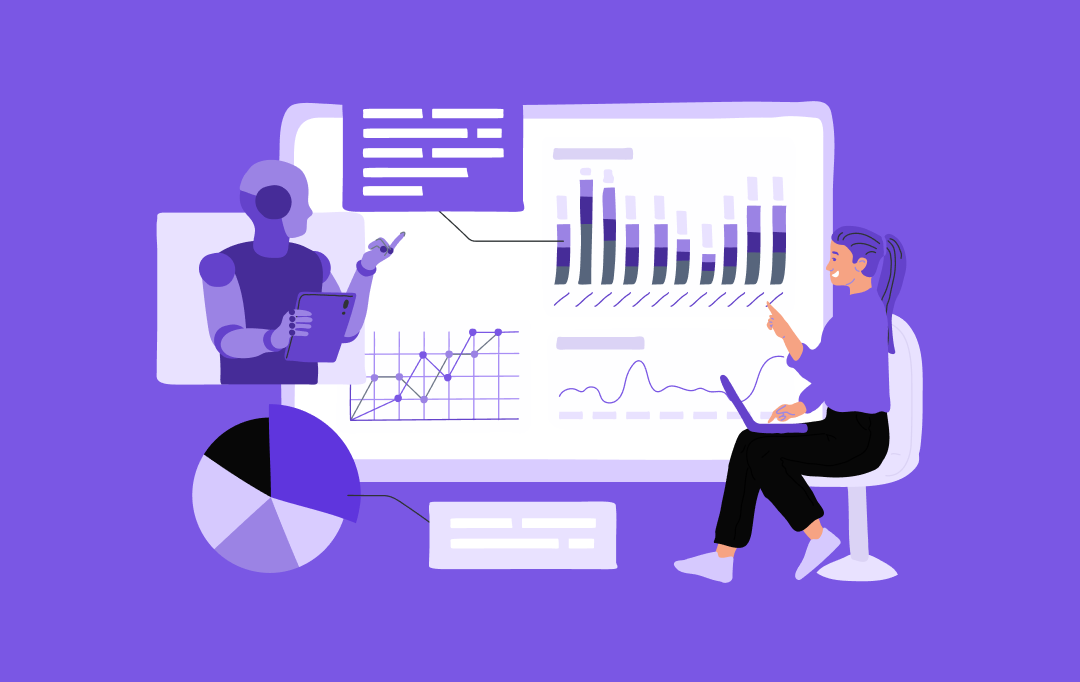
Why Enterprises Need AI Strategy Consulting in Dubai
Key takeaways: Dubai is moving fast with AI adoption. But many enterprises still struggle to move beyond pilots and achieve real business results. AI strategy consulting gives leaders a clear plan. From use-case selection to data readiness, so enterprise AI initiatives stay on track and within budget. AI consulting in Dubai helps enterprises reduce compliance…
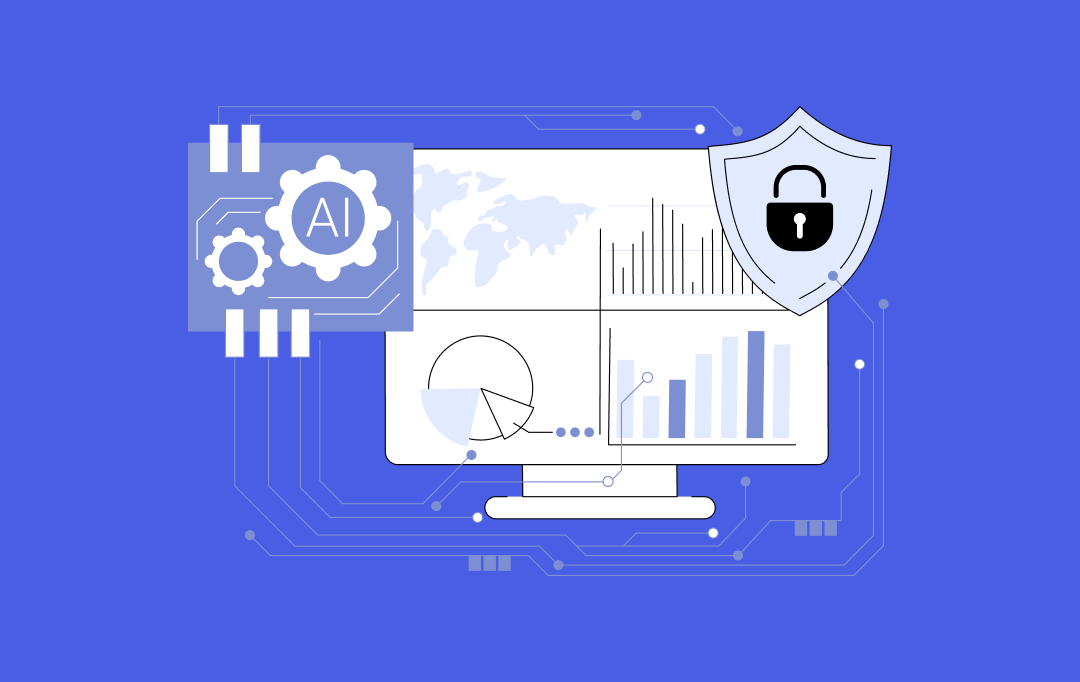
AI Governance Consulting: How to Build Guardrails, Observability, and Responsible AI Pipelines
Key takeaways: Enterprises can no longer rely on principles alone; AI governance must be built into pipelines, model workflows, and decision systems from day one. Strong guardrails across training, inference, retrieval, and agentic actions reduce risks like hallucinations, data leakage, and prompt injection. AI observability is central to governance, giving leaders real-time visibility into drift,…

How to Build a Custom Multilingual Chatbot? Features, Process, Costs
Key takeaways: Multilingual Chatbots Drive Revenue Growth: Companies see higher conversion rates when customers can interact in their native language, with nearly 75% of global customers preferring to buy from websites in their preferred language. Beyond Translation to Cultural Intelligence: Successful implementations require cultural adaptation, not just language translation. Systems must understand context, emotion, and…
























